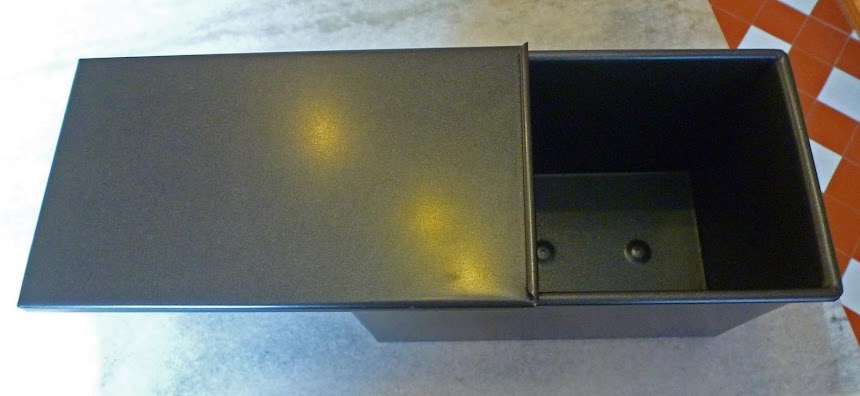Making my own bread that can be sliced and used for sandwiches or toast isn't too hard to do. The hardest part of making French-style pain de mie in the new loaf-pan-with-a-lid, I think, is going to be figuring out how much dough to make.

For a first experiment, this loaf was mostly a success, but not completely. It's good, but my dough didn't rise enough to fill up the pan. So instead of a squared-off loaf, I ended up with one that has a rounded top. I need either more yeast, or more potent yeast, or just more dough.
I also think I cooked my bread slightly too long, or at too high a temperature, so it got very brown. Pain de mie isn't supposed to have a real crust, but mine does. Anyway, it tastes good as toast with confiture (jam). The slices of toast don't really need to be buttered because there's already butter in the dough. I think I'll go make some toast now... Here's the recipe I followed for the bread, converted from metric to American measures.
Pain de mie
4 cups all-purpose flour (500 grams)
2 tsp. salt (12 g)
2 Tbsp. sugar (25 g)
2 tsp. dry active yeast (5 g)
4 Tbsp. butter, softened (50 g)
4 fl. oz. milk (100 ml)
8 fl. oz. warm water (200 ml)
Take the butter and milk out of the refrigerator in advance to let them warm up. Cut the softened butter into little cubes.
Mix together the flour, salt, and sugar in a big bowl, or in the bowl of a stand mixer. Stir them together well.
Put the yeast in the warm water and let it stand for 10 minutes until it starts foaming. Pour the yeast mixture along with the warm milk into the bowl with the dry ingredients and mix well to form a ball of dough. Add the soft butter and knead for two or three minutes by hand or with the dough hook if using a stand mixer.
Add a little more flour if the dough is too sticky, or more water teaspoonful by teaspoonful if it seems too dry. Shape the dough into a ball, cover the bowl, and let the dough rise for an hour or more until it doubles in size.
Punch the dough down, knead it again briefly, roll it into a log shape, and put it in an oiled loaf pan. Cover the pan and let the dough rise again for 60 to 90 minutes in a warm place.
When the dough has again doubled in volume, put it in the oven. Turn the temperature down to 175ºC (350ºF) and let the bread bake for 30 to 40 minutes, until light golden brown. It should sound hollow when you thump it.
Pre-heat the oven to 200ºC (400ºF).






To me it looks like a great success. With my bread machine, never do I get the same result from one loaf to the other. It all depends on the amount of yeast and of water, a little less or a little more makes all the difference, but also on the temperature of the ingredients. It depends also, probably, on room temperature for the rising of the dough. Keep up the good work!
ReplyDeleteI'm going to keep making bread like this every week, varying the ingredients and process slightly each time to see what I like best.
DeleteIt just dawned on me, after years of being mystified by the term, what pain de mie actually means. "Bread of..." — we don't have a word for mie in English; we just call it "the soft part" or "the inside" of the bread. I think the pain in pain de mie is like the pain in pain de viande (meatloaf). It means "loaf" rather than "bread." Since the mie is the soft part of the bread, pain de mie means a "soft loaf." Another way of saying that would be "crustless bread," I guess, as opposed to "French bread," which has a crunchy crust. There is also a colloquial expression in American English, and maybe other varieties of English: "loaf bread." Now I wonder why we say that. I guess it means it's not cornbread or rolls (petits pains).
I’m sure you’re right about the meaning of pain in pain de mie, loaf it is, like in pain de sucre, sugar loaf!
DeleteCNRTL gives a number of acceptations of the word pain, meaing a mass of something. Interesting.
Yumm--that bread looks tasty, Ken. I'll be interested in checking out that link later today.
ReplyDeleteI hope you'll keep us apprised of your trials with the weekly pain de mie making.
Judy
That's beautiful!
ReplyDeleteThat bread looks VERY appetizing to me. :))
ReplyDeleteTaste is more important than looks- yours is almost perfect.
ReplyDeleteThis bread is very good, especially with strawberry jam. I'm going to make another "loaf bread" tomorrow, using a recipe I found on the BBC website.
DeletePS don't forget to make plenty of plum preserves and or jelly this pain de mie year!
ReplyDeletePullman loaves of bread have an interesting history in the USA. It starts with the RR in Chicago.
ReplyDeleteI had never heard of Pullman loaves or Pullman bread pans until today. I certainly hope we get a lot of plums for jelly and jam this summer and fall.
Delete